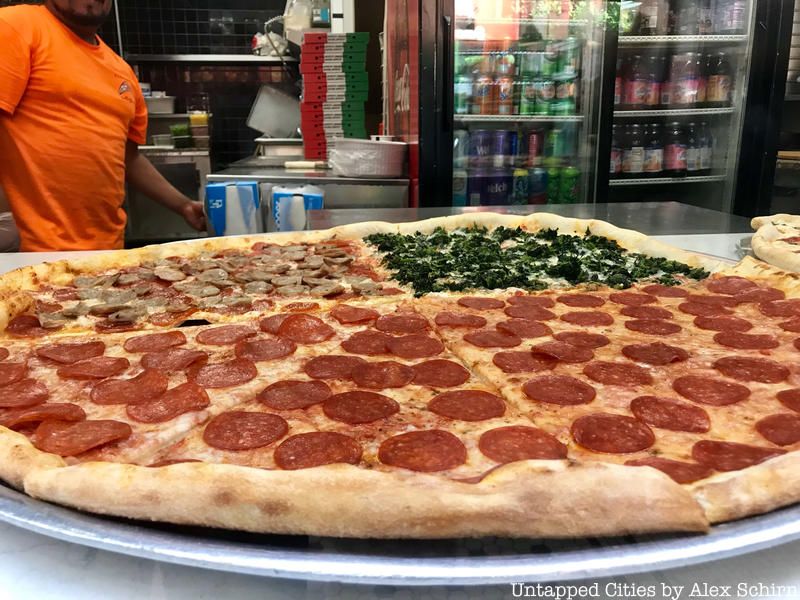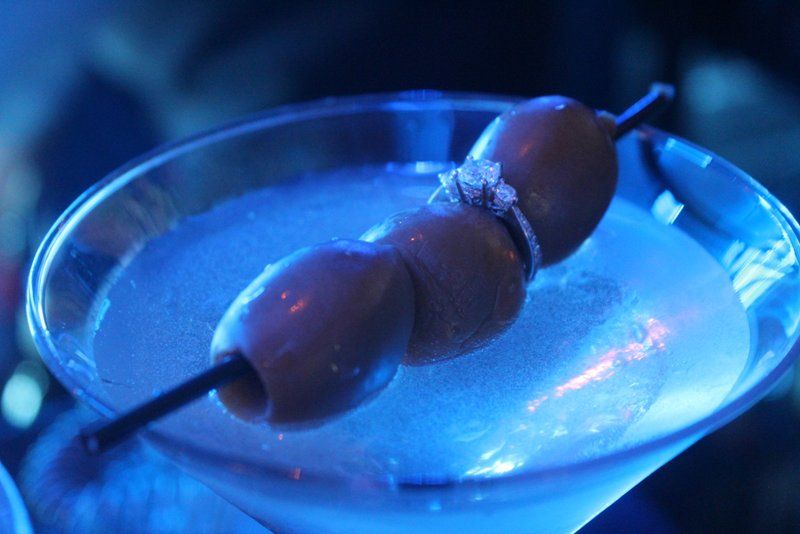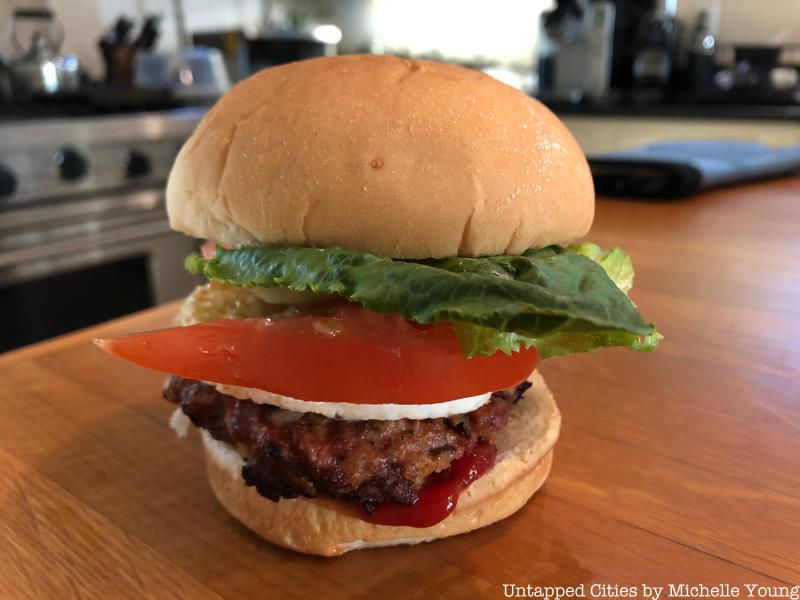NYC’s Forgotten ‘War on Christmas Trees’
Discover how an obscure holiday crackdown affects festive street vendors today!



Sugar Factory’s King Kong Sundae. Image by Matt Harbicht, Food Network courtesy one 7 communication.
What’s better than drinks and dinner? How about the biggest, oldest, and most expensive New York City drinks and dinner? From cocktails the size of your head to warring myths surrounding classic cuisine staples, New York City has it all when it comes to the culinary world. So if you want to truly experience the city’s cuisine, why not seek out only the best, biggest, oldest, most expensive, or even the most aesthetic options? With that said, here are 10 foods and cocktails honored with citywide, or even national, superlatives, as well as the stories behind their claims to fame.
If impractically oversized cocktails have ever quite literally taken lead roles in your dreams, you’re in luck. The dream is now a reality with Dream Hotels’ (pun intended) 10-pound Moscow Mule. Enjoy this classic cocktail in a copper mug as big as you head at both the PHD Terrace at Dream Midtown and PHD Rooftop Lounge at Dream Downtown. The recipe is simple– just 164-ounces composed of 18 ounces of Belvedere vodka or Casamigos Blanco Tequila, a few ounces of lime juice, Owen’s all-natural mule mix, and garnishes of limes and mint to finish.
Though the $185 price tag isn’t as dreamy as the drink, perhaps that just makes it an excuse to bring ten of your closet friends to help share in the experience with the added bonus of then being able to casually implement the buddy system while stumbling home.

Another edible, larger-than-your head New York City staple are the slices at Koronet Pizza. Koronet Pizza’s metal circular trays were custom-made to carry their monster pies. Koronet manager Peter Manikis explains in a radio interview with Cyrus Farivar for Columbia Radio News why the slices are so large: “There’s no reason. It’s just American pizza. Big pies, that’s all.” Each pizza pie comes in two pizza boxes and there is about a quarter pound of cheese in every slice.
There are two locations to get your fix: Morningside Heights at 2848 Broadway (110th Street) and Washington Heights at 4087 Broadway (172nd Street). Their crown jewel is the Jumbo slice–from a 32-inch pizza–that’ll only set you back about $4, with their more conservative “small” pizza coming in at 16 inches.

The oldest cocktail created in New York City is surrounded in swirling clouds of myth by various historic bars and restaurants claiming to have created the first “insert-classic-drink-here.” For example, rumor has it that the Manhattan was created at the Manhattan Club, but there are reports claiming that it was in fact started somewhere on Broadway and Houston Street in the 1860s. One New York City origin story that puts up quite a fight for the city’s right to ownership is the Martini.
Some would assert that the Martini was actually created in San Francisco in the 1800s, but the Knickerbocker hotel holds that Martini was first invented in 1912 in the Knickerbocker Hotel’s ballroom, by the bartender– wait for it– Martini di Arma di Taggia! You can still enjoy the original recipe today at the Knickerbocker in a balanced concoction of gin, dry and rouge vermouth, and orange and citrus bitters.

Photo by Ann-Sophie Fjelloe-Jensen/New York Hall of Science
Not just another New York City “most,” but also a Guinness World record holder, is the largest gingerbread village entitled affectionately by it’s creator as “Gingerbread Lane.” As of the end of 2016, the two-and-a-half-ton Gingerbread Lane was going on its fourth straight year of being the largest gingerbread village in the world with Bronx resident and chef, Jon Lovitch breaking his own record every year. This past year’s village featured 1,251 houses made entirely of edible gingerbread, royal icing and candy. The houses are drafted, designed, baked, planned, built and decorated all by Lovitch over the course of each year.
The secret to Lovitch’s success? “I get everything as cheap as I can,” Lovitch told abc7 news. “Candy, I get the day after Christmas, day after Valentine’s Day and after Halloween. It’s all on sale. You see a theme here?”
The 2016’s Gingerbread Lane is no longer on display, but it was on view for all to see at the New York Hall of Science in Corona, Queens for just over two months from the end 2016. However, if Lovitch stay’s the course, don’t be surprised to see a bigger, better, new-recording-holding version of Gingerbread Lane again at the end of 2017.
 Photo courtesy Algonquin Hotel
Photo courtesy Algonquin Hotel
The Algonquin on West 44th Street is a 181-room hotel that opened in 1902 that saw its rebirth as a literary haunt in the ’20s and ’30s when its owner and manager Frank Case transformed the place into a popular meeting place for writers. To this day, it offers discounted rooms to struggling writers in return for an autographed book and has housed a cat, either named Mathilda or Hamlet depending on the gender, in honor of the hotel’s original cat since the 30s.
However, if you head to the hotel’s newer Blue Bar, you’ll get quite the opposite feeling from the humble patrons the hotel is known for. The Blue Bar has been serving what it calls a “Martini on the Rock” since its $3 million renovation in 2005– a martini of the customer’s choice with with a diamond, its single ‘rock,’ placed at the bottom. The drink costs $10,000.
Ordering the “$10,000 Martini” is coincidentally not as easy as walking up to the bar. In fact, reservations for the drink must be made at least 72 hours in advance and requires a meeting with the hotel’s in-house jeweler to discuss the diamond in question’s size and clarity. The hotel prefers that the drink be used for marriage proposals, but doesn’t outrightly say it won’t sell its Martini on the Rock to someone simply looking to treat themselves.

Again, New York City has been home to the inventions of some of the world’s most classic cuisines– the Waldorf Salad at the Waldorf Astoria, Chicken and Waffles in Harlem’s Well’s Restaurant, and the Pastrami and Corned Beef Sandwich combination from Katz Deli just to name a few. However, one signature dish whose history is a little murkier is also the one that’s considered to be one of New York’s oldest food creations: Eggs Benedict. While New York City’s oldest restaurant, Delmonico’s, is widely credited with the brunch-staple’s invention, it appears that the Waldorf Salad wasn’t the only dish thought to be created at the hotel.
As legend has it, in 1894, Wall Street broker Lemuel Benedict was looking for a hangover cure at the Waldorf Astoria when he asked for the combination as we know it today. However, it was eventually established by the New York Times in 1942 after intense research that toast, and not English Muffins, had been asked for by Benedict. Therefore, the crown and claim goes to Delmonico’s for the recipe as originally published in the cookbook of Delmonico’s chef Charles Ranhofer, “The Epicurean,” which came out the same year as Benedict asked for his version of a hangover cure at the Waldorf. This would eventually inspire the nephew of Benedict, Jack Benedict, to start an actual campaign in the late 1970s to reclaim the fame, which promptly received 15 rejection letters from the various magazines he tried to court.

Though the original burger, or “hamburgs” as they were originally called, were nothing more than the basic patty, even minus the bun– fairly unrecognizable from the apple-wood smoked bacon and blue cheese-adorned dishes of today– New York City ports of the early 1800s claim this American classic as their own. As the story goes, what’s now considered perhaps America’s most classic dish started as a way to give homesick German sailors a taste of home– home being Hamburg, Germany along the North Sea.
Not to usurp the legacy of Eggs Benedict, we’re placing New York City’s rather charitable invention of the hamburger in its own category of oldest New York City cuisine staples. The first time the burger was noted on on an actual menu wasn’t until 1873 at Auguste Ermisch’s German restaurant a good 50 years after its port appearance, according to Andrew F. Smith in Hamburger: A Global History.
However, we’d also like to give a special shoutout to the oyster, which more than likely, was being shucked and quite possibly taken in shooter form by the Native Americans long before the the Big Apple was a seedling.

Though rainbow-colored food has taken the culinary world by storm and even trickled its way into the corporate mainstream (Starbucks’ Unicorn Cappuccino being the best defense for that argument), when Brooklyn’s The Bagel Store released their Rainbow Bagel, multi-colored food was still an anomaly. Referring to the rainbow bagel as “The bagel that broke the internet,” as The Bagel Store website subtitles it, isn’t all that far off. Though the twisted neon dough has been around for a little over 20 years, it’s just recently been gone viral largely thanks to this 2016 video from Insider Food.
Today, the fad continues as social media users continue to publicize their rainbow treat before devouring the bagel, which is usually filled with funfetti cream cheese. No longer do geographical boundaries seem to matter, as The Bagel Store now ships their $3.95 rainbow bagels to customers nationwide. Be sure it’s not a impulse order, however, as you’ll more than likely have to put yourself on their waiting list. Or if you don’t feel like spending the four bucks, you can still appreciate the bagel’s aesthetic all over Instagram.

Sugar Factory’s King Kong Sundae.Image by Matt Harbicht, Food Network courtesy one 7 communication.
Speaking of Instagram, at the end of 2016, the photo sharing social media platform announced its running list of most geotagged locations around the world. At the top of the list for United States restaurants is New York City’s Sugar Factory in the meatpacking district.
Now open in two locations in New York, with the Upper West Side location opening at the end of 2016, the Sugar Factory is best known for its smoking, boozy fish bowls and world-famous “Couture Pops,” which are bedazzled lollipops meant to be both a sweet treat and an accessory. These pops, though appearing to be simple lollipops, have made their way to the red carpet and been endorsed for special lines and signature series by the likes of international superstars including Kylie Jenner, Kendall Jenner, Britney Spears, Drake, Nicole Scherzinger, Kim Kardashian, Eva Longoria and Rupert Grint among others. In fact, it’s the success these pops have brought to the company that allowed founder Charissa Davidovici to expand from her Las Vegas flagship she opened in 2010 to over 20 locations in various cities and forms of the shop, including lounges, festivals, and even a Las Vegas fashion show.
However, visitors don’t only come to the sugar factory to run into to celebrities, enjoy the $30 pops, or to Instagram either of those things, but also to “shop.” Anyone is welcome to select from over 300 options at their “retail section”– the term they use for their menu– which also includes merchandise, as well as savory options. Breakfast, lunch, dinner, late-night munchies and brunch foods are all up for sale.
New York City’s most expensive dish is extremely intriguing (and mildly appalling) for two reasons. First, it’s a mind-boggling $2,300, and second, because it’s a hot dog. Yes, the very same messy food item that New Yorkers can get for roughly $3 at any street corner or enjoy while sitting in plastic folding chairs and yelling between bites during at a baseball game is over $2,000 at Midtown‘s swanky hotel and rooftop bar: 230 Fifth.
230 Fifth’s hot dogs can actually be purchased for as low as $20, but if one wants the luxury dog, they should prepare themselves to leave the noticeably lighter pockets. The luxury dog is special because it contains 60-day dry-aged wagyu sausage, filled with cognac, sprinkled with a mushroom dust, and garnished with lobster and black truffles among a few of the add ons. Luckily, 230 Fifth gives customers some built in mental-preparation time as the luxury dog has to be ordered 48 hours in advance. Oh, and be sure they don’t forget to add the gold leaf…
For more on quirky New York City cocktails check out 10 of Manhattan’s Best Hidden Underground Bars & Lounges or on the cuisine side, the Top 10 Hidden Restaurants in New York City. Get in touch with the author: @Erika_A_Stark.
Subscribe to our newsletter